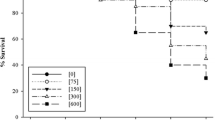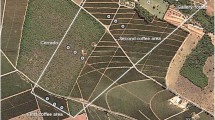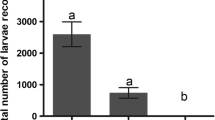Abstract
Soil texture, chemistry and moisture have a profound effect upon the activity and persistence of entomopathogenic nematodes (EPNs). Whereas nematodes’ natural habitat is within the soil, ticks and other arthropod pests prefer to stay on the soil surface and under stones or leaf litter; they spend much of their life cycle in the humid environment of the soil upper layer, therefore consideration of the effect of the soil environment on nematode activity is a pre-requisite for the sucessful use of EPNs against arthropod pests. In the present study we investigated the effects of soil type, and humidity on various nematode strains and on their effectiveness against ticks. Many infective juveniles (IJs) of Steinernema carpocapsae and S. riobrave were found in the uppermost soil layer whereas the heterorhabditid strains were almost absent from the upper 6 cm of the soil profile. The IJs of S. feltiae, and the S. carpocapsae strain S-20, exhibited an intermediate behavior. It was found that the activity of IJs of S. carpocapsae in the soil upper layer (1 cm depth) was strongly affected by soil type: the greatest number of IJs were recorded from sandy loam soil; less were found in the lighter soils – ‘Marine sand’ and ‘Calcareous sandstone’ – and only very few were recovered from heavy soils. Strikingly, even when the soil moisture was low and the number of nematodes found in the upper layer correspondingly low, tick mortality remained high. The results demonstrate: (a) the possible use of the nematodes as an anti-tick agent; (b) the importance of knowing the exact interaction of nematodes with the immediate environment of the pest, in order to optimize the pest-control activity of the nematode.
Similar content being viewed by others
References
Anonymous, 1996. SAS lifetest. In: SAS/TEST Users guide, SAS Institute Inc., Cary, North Carolina, 846
Caroli L., Glazer I. and Gaugler R. (1996). Entomopathogenic nematode infectivity bioassay: comparison of penetration rate into different hosts. Biocontrol Sci. Technol. 6: 227–233
Choo H.Y., Kaya H.K., Burlando T. and Gaugler R. (1989). Influence of plant roots on nematode host-finding ability. Environ. Entomol. 18: 1136–1140
Dowds B.C.A. and Peters A. (2002). Virulence mechanism. In: Gaugler, R. (eds) Entomopathogenic Nematodes, pp 99–114. CABI Publishing, Wallingford, UK
Gaugler R. and Han R. (2002). Production technology. In: Gaugler, R. (eds) Entomopathogenic Nematology, pp 289–310. CABI Publishing, Wallingford, UK
Georgis R. and Manweiler S.A. (1994). Entomopathogenic nematodes: A developing biocontrol technology. In: Evans, K. (eds) Agricultural Zoology Reviews, pp 63–94. Intersept, Andover
Glazer I. and Lewis E.E. (1998). Bioassays for entomopathogenic nematodes. In: Navon, A. (eds) Bioassays For Entomopathogens and Nematodes, pp 274–293. Kluwer, Dordrecht
Glazer I., Alekseev E. and Samish M. (2001). Factors affecting the virulence of entomopathogenic nematodes to engorged female Boophilus annulatus ticks. J. Parasitol. 87: 808–812
Grewal P.S. (2002). Formulation and application technology. In: Gaugler, R. (eds) Entomopathogenic Nematology, pp 265–287. CABI Publishing, Wallingford, UK
Hassanain M.A., Derbala A.A., Abdel-Barry N.A., El-Sherif M.A. and El-Sadawe H.A. (1997). Biological control of ticks (Argasidae) by EPNs. Egypt. J. Biol. Pest Cont. 7: 41–46
Hill D.E. (1998). Entompathogenic nematodes as control agents of developmental stages of the black-legged tick, Ixodes scapularis. J. Parasitol. 84: 1124–1127
Kaaya G.P., Glazer I. and Samish M. (1999). Laboratory evaluation of pathogenicity of entomopathogenic nematodes to African tick species. Ann. NY Acad. Sci. 916: 303–308
Kaya H.K. (1990). Soil ecology. In: Gaugler, R. and Kaya, H.K. (eds) Entomopathogenic Nematodes in Biological Contol, pp 93–115. CRC Press, Boca Raton, Florida
Kaya H. and Gaugler R. (1993). Entomopathogenic nematodes. Ann. Rev. Entomol. 38: 181–206
Kaya H.K. and Stock S.P. (1997). Techniques in insect nematology. In: Lacry, L. (eds) Manual of Techniques in Insect Pathology, pp 281–324. Academic Press, San Diego, London
Kung S.P., Gaugler R. and Kaya H.K. (1990). Soil type and entomopathogenic nematode persistence. J. Inv. Pathol. 55: 401–406
Lewis L.E. (2002). Behavorial ecology. In: Gaugler, R. (eds) Entomopathogenic Nematodes, pp 205–224. CABI Publishing, Wallingford, UK
Mauleon H., Barre N. and Panova S. (1993). Pathogenicity of 17 isolates of entomophatogous nematodes (Steinernematidae and Heterorabditidae) for the ticks Amblyomma variegatum (Fabricius), Boophilus microplus (Canestrini) and Boophilus annulatus (Say). Exp. Appl. Acarol. 17: 831–838
Moyle P. and Kaya H.K. (1981). Dispersal and infectivity of entomopathogenic nematodes, Neoaplectana carpocapsae Weiser (Rhabditia: Steinernematidae), in sand. J. Nematol. 13: 295–300
Norton D.C. (1978). Ecology of Plant-Parasitic Nematodes. John Wiley, New York, 128–132
(1979). Nematodes for Biological Control of Insects. CRS Press, Boca Raton, FL
Samish M. and Glazer I. (1992). Infectivity of entomopathogenic nematodes (Steinernematidae and Heterorhabditidae) to female ticks of Boophilus annulatus (Arachnida: Ixodidae). J. Med. Entomol. 29: 614–618
Samish M. and Glazer I. (2001). Entomopathogenic nematodes for the biocontrol of ticks. Trends Parasitol. 17: 368–371
Samish M., Alekseev E.A. and Glazer I. (1999). Efficacy of entomopathogenic nematode strains against engorged Boophilus annulatus females (Acari: Ixodidae) under simulated field conditions. J. Med. Entomol. 36: 727–732
Samish M., Alekseev E. and Glazer I. (2000a). Efficacy of entomopathogenic nematode strains against engorged Boophilus annulatus (Say) female ticks (Acari: Ixodidae) under simulated field conditions. J. Med. Entomol. 36: 727–732
Samish M., Alekseev E. and Glazer I. (2000b). Interaction between ticks and pathogenic nematodes: the susceptibility of various tick species at different developmental stages. J. Med. Entomol. 36: 733–740
Samish M., Alekseev E. and Glazer I. (2000c). Mortality rate of adult ticks due to infection by entomopathogenic nematodes. J. Parasitol. 86: 679–684
Zhioua E., Lebrun R.A., Ginsberg H.S. and Aeschlimann A. (1995). Pathogenicity of Steinernema carpocapsae and S. glaseri (Nematoda: Steinernematidae) to Ixodes scapularis (Acari: Ixodidae). J. Med. Entomol. 32: 900–905
Author information
Authors and Affiliations
Corresponding author
Rights and permissions
About this article
Cite this article
Alekseev, E., Glazer, I. & Samish, M. Effect of Soil Texture and Moisture on the Activity of Entomopathogenic Nematodes Against Female Boophilus annulatus Ticks. Biocontrol 51, 507–518 (2006). https://doi.org/10.1007/s10526-005-2935-9
Received:
Accepted:
Published:
Issue Date:
DOI: https://doi.org/10.1007/s10526-005-2935-9




